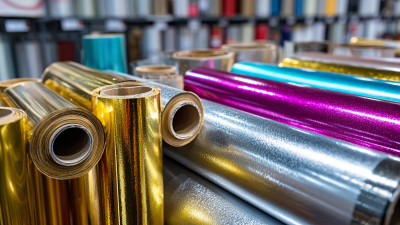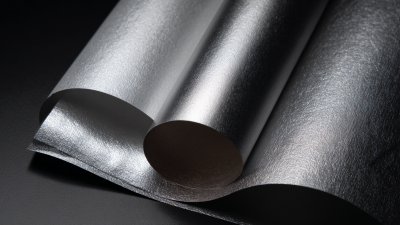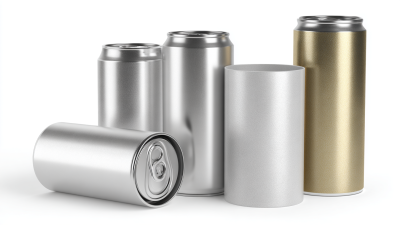The Surprising Science of Tin Foil: Uncovering Its Hidden Uses in Everyday Life
 Tin foil, commonly known as aluminum foil, has long been a staple in kitchens around the world, primarily used for cooking and food storage. However, recent studies reveal that its applications extend beyond culinary uses to encompass various surprising functions in everyday life. According to a report by the Aluminum Association, the demand for aluminum foil has surged over the past decade, with an estimated global market worth over $10 billion by 2025. This growth is driven not only by its versatility in food preservation and packaging, but also by innovative applications in areas such as electromagnetic shielding, insulation, and even health-related uses. As consumers become more environmentally conscious, the sustainable aspects of tin foil, including its recyclability and energy-efficient production processes, further highlight its importance in our daily routines. Uncovering these hidden uses can transform our understanding of this simple material, showcasing its multifaceted benefits and contributing to more efficient living.
Tin foil, commonly known as aluminum foil, has long been a staple in kitchens around the world, primarily used for cooking and food storage. However, recent studies reveal that its applications extend beyond culinary uses to encompass various surprising functions in everyday life. According to a report by the Aluminum Association, the demand for aluminum foil has surged over the past decade, with an estimated global market worth over $10 billion by 2025. This growth is driven not only by its versatility in food preservation and packaging, but also by innovative applications in areas such as electromagnetic shielding, insulation, and even health-related uses. As consumers become more environmentally conscious, the sustainable aspects of tin foil, including its recyclability and energy-efficient production processes, further highlight its importance in our daily routines. Uncovering these hidden uses can transform our understanding of this simple material, showcasing its multifaceted benefits and contributing to more efficient living.
The Versatile Applications of Tin Foil in Food Preparation and Storage
Tin foil, also known as aluminum foil, is a staple in many kitchens due to its versatility in food preparation and storage. One of the primary uses of tin foil is for wrapping food items, which helps to preserve their freshness and prevent moisture loss. When you wrap a sandwich or leftovers, the foil acts as a barrier against air, keeping the food from drying out or absorbing unwanted odors from the refrigerator. This makes tin foil an excellent choice for packing lunches or storing cooked meals.
In addition to its wrapping capabilities, tin foil is commonly used for cooking and baking. It can be lined on baking sheets to ensure easy clean-up, and its heat-resistant properties make it ideal for covering dishes in the oven to prevent over-browning. Chefs often use foil to create makeshift lids that help to retain steam, thus infusing moisture into meats and vegetables while they cook. Furthermore, tin foil is useful for creating custom molds for food items, such as baking cakes or shaping portions for individual servings. Its adaptability in various food-related tasks highlights why it remains an essential item in any kitchen.
Statistics on the Environmental Impact of Aluminum Foil Usage
Aluminum foil, a common household item, has a significant environmental footprint that often goes unnoticed. According to the Aluminum Association, the production of aluminum—required for making foil—accounts for nearly 2% of global greenhouse gas emissions. When considering that approximately 1.4 million metric tons of aluminum foil are used annually in the U.S. alone, the cumulative impact becomes alarming. Each roll of aluminum foil embodies the energy equivalent of about 8.5 kWh, enough to power a typical laptop for several days.
The recycling rate for aluminum is impressively high, standing at around 75% in the U.S. This is important, as recycling aluminum can save up to 95% of the energy needed for primary production. However, the reality is that a significant portion of used foil ends up in landfills, where it can take over 400 years to decompose. Several studies, including one by the Environmental Protection Agency, have highlighted that while aluminum foil is lightweight and convenient, addressing its disposability can lead to substantial environmental benefits. By adopting practices such as re-using and recycling, households can mitigate the ecological impacts associated with aluminum foil use.
Innovative Ways to Use Tin Foil for Home Maintenance and Repairs
 Tin foil, commonly known as aluminum foil, is not just a kitchen staple for wrapping leftovers; it can serve a multitude of innovative functions in home maintenance and repairs. According to a report by the Aluminum Association, aluminum foil is 100% recyclable and has a low environmental impact, making it a sustainable choice for a variety of household tasks. One surprising use includes creating a makeshift funnel for pouring liquids, which can help prevent spills during home repairs. A study published in the Journal of Home Economics found that nearly 40% of homeowners engage in DIY projects that require creative solutions like these.
Tin foil, commonly known as aluminum foil, is not just a kitchen staple for wrapping leftovers; it can serve a multitude of innovative functions in home maintenance and repairs. According to a report by the Aluminum Association, aluminum foil is 100% recyclable and has a low environmental impact, making it a sustainable choice for a variety of household tasks. One surprising use includes creating a makeshift funnel for pouring liquids, which can help prevent spills during home repairs. A study published in the Journal of Home Economics found that nearly 40% of homeowners engage in DIY projects that require creative solutions like these.
Another practical application of tin foil is in improving the efficiency of household appliances. By lining the interior of an oven or toaster oven with tin foil, users can reflect heat and distribute it more evenly, leading to better cooking results. The Energy Saving Trust suggests that this simple step can reduce energy consumption during cooking, demonstrating that a little foresight can lead to cost savings as well as enhanced performance. Furthermore, aluminum foil can be used to create a makeshift repair for broken wires or cables, offering an immediate solution until a more permanent fix is sought. This versatility showcases the hidden benefits of tin foil that can significantly contribute to efficient home maintenance.
The Role of Tin Foil in Improving Energy Efficiency in Households
Tin foil, commonly known as aluminum foil, plays a surprisingly pivotal role in enhancing energy efficiency within households. Recent studies indicate that the reflective properties of tin foil can help to optimize heating and cooling systems by minimizing heat loss. According to the U.S. Department of Energy, proper insulation in homes can reduce energy bills by as much as 20-30%. By placing tin foil behind radiators, homeowners can reflect heat back into the room rather than allowing it to escape through walls, ultimately supporting a more energy-efficient environment.
Moreover, tin foil can be used effectively in the kitchen. For instance, covering windows with aluminum foil during colder months can help retain heat while also blocking drafts. A study from the National Renewable Energy Laboratory (NREL) found that simple interventions, such as using foil-covered surfaces, can improve a household's overall energy performance, thereby reducing dependence on heating systems. The integration of tin foil into daily life not only showcases its versatility but also highlights its underappreciated ability to contribute to substantial energy savings and lower carbon footprints for families.
Health Benefits of Using Tin Foil for Cooking and Food Preservation Techniques
 Tin foil, often underestimated, offers remarkable health benefits in cooking and food preservation. Studies show that using aluminum foil can significantly reduce cooking time and maintain food quality. According to a report by the Food Packaging Forum, wrapping food in aluminum foil can help prevent contamination from air and bacteria, extending its shelf life by up to 50%. This is particularly useful for perishable items, ensuring that your meals remain fresh and nutritious for longer periods. Additionally, heat conduction properties of tin foil allow for even cooking, which can enhance flavors while minimizing the need for additional oils or fats.
Tin foil, often underestimated, offers remarkable health benefits in cooking and food preservation. Studies show that using aluminum foil can significantly reduce cooking time and maintain food quality. According to a report by the Food Packaging Forum, wrapping food in aluminum foil can help prevent contamination from air and bacteria, extending its shelf life by up to 50%. This is particularly useful for perishable items, ensuring that your meals remain fresh and nutritious for longer periods. Additionally, heat conduction properties of tin foil allow for even cooking, which can enhance flavors while minimizing the need for additional oils or fats.
Tips: When using tin foil for grilling, create a pouch for delicate foods like fish or vegetables to preserve moisture and flavor. If you’re storing leftovers, ensure the foil is tightly wrapped to reduce oxidation, which can degrade taste and nutrients. Lastly, avoid using aluminum foil with acidic foods like tomatoes or citrus, as this may cause a reaction that impacts food taste and safety. By incorporating these techniques, you can maximize the health benefits of tin foil in your daily cooking routine.
Related Posts
-

Exploring Market Trends for Wrapping Foil at the 138th Canton Fair 2025 in China
-

Ultimate Guide to Creative Uses of Tin Foil in Everyday Life
-

5 Tips for Maxing Out the Benefits of Alu Foil in Your Kitchen
-

Exploring Silver Foil Paper Trends and Market Dynamics at the 138th Canton Fair 2025 in China
-

What is the Role of Aluminium Packaging in Modern Sustainability?
-

Unlocking the Benefits of Aluminum Foil: Your Guide to Choosing the Right Supplier
